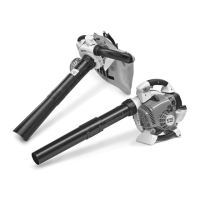
 Loading...
Loading...
Do you have a question about the Stihl SH 56 and is the answer not in the manual?
| Maximum input power | - W |
|---|---|
| Airflow | 730 m³/min |
| Noise level | 105 dB |
| Bag capacity | 45 L |
| Product color | Black, White |
| Vibration emission | 9.1 m/s² |
| Weight | 5400 g |
|---|
Explains graphical symbols and text markings used for instructions and warnings.
Explains safety symbols and warns against lending the tool without the manual.
Operator's physical/mental state, fatigue, vibration effects, and pacemaker warnings.
Importance of appropriate clothing, eye protection, hearing protection, and footwear.
Warnings about proper assembly, avoiding modifications, and using authorized parts.
Safety precautions for transporting the tool in a vehicle.
Information on fuel mixture, safe fueling, and leak checks.
Essential checks of tool condition, controls, and spark plug boot before operation.
Instructions for safely starting the engine, including location and priming.
Safety for one-person operation, starting techniques, and keeping children away.
Guidelines for safe handling, terrain, and working conditions.
Warnings about inhaling dust, organic dusts, asbestos, and silica.
Advice on commercial substances, asbestos hazards, and respiratory precautions.
Emergency stop, bystander safety, fan rotation, and foreign object warnings.
Warning about hot muffler and engine parts after operation.
Instructions for operating the vacuum shredder, including grip and bag strap.
Warnings for vacuum attachment operation, intake screen, and not picking up hot substances.
Specific safety precautions for catalytic converters regarding heat and placement.
Guidelines on using genuine parts and performing maintenance/repairs.
Precautions to take before performing maintenance or repairs.
Instructions for operating the blower, including nozzle types and noise sensitivity.
Instructions for operating the vacuum shredder, including grip and bag strap.
Advice on handling abrasive materials during vacuuming to prevent wear.
Techniques to minimize air pollution, noise, and save water.
Step-by-step instructions for attaching the blower tube.
Instructions for attaching the elbow to the catcher bag and housing.
Steps for assembling the suction tube to the fan housing.
Specifies the type of gasoline and oil mixture required for the engine.
Guidance on mixing and storing fuel, and its shelf life.
Safety warnings and procedures for filling the fuel tank.
Steps for starting the engine, including priming the bulb.
Instructions for setting the lever for starting on specific models.
How to set the choke knob for cold engine starts.
How to set the choke knob for warm or recently run engines.
Steps for placing the unit, holding, and pulling the starter grip.
Advice for troubleshooting starting issues and when the engine stops or fails to start.
Action to take immediately after the engine starts to set idle speed.
How to stop the engine using the stop switch or setting lever.
Instructions for removing, cleaning, and installing the air filter.
Factory settings for the carburetor for optimal performance.
Adjustments for satisfactory engine power at different altitudes.
How to inspect, clean, and gap the spark plug for troubleshooting.
When to replace the spark plug.
Procedures for draining fuel, cleaning, and storing the machine for 3+ months.
Checking the spark arresting screen for power loss issues.
Explanations of the function of key components.
Emission compliance periods based on federal standards.
Emission compliance periods based on California standards.
Displacement, bore, stroke, idle speed, and power rating of the engine.
Air flow rates and dry weight specifications for the machine.
Specifications for ignition, fuel system, air velocity, and fuel tank capacity.
Information on how to inquire about available special accessories.
Guidelines on user maintenance, repair limitations, and warranty claims.
How to identify genuine STIHL replacement parts.
Indicates this statement is not applicable to California.
Explains U.S. EPA regulations and owner's responsibilities for emission control warranty.
Defines the warranty period, diagnosis procedures, and associated costs.
How warranty defects are remedied and owner's maintenance responsibilities.
Indicates this statement applies exclusively to California.
Explains California ARB standards and owner's responsibilities for emission control warranty.
STIHL's warranty for design, build, and freedom from defects for a specified period.
Details the warranty period for defects and component replacement.
Lists components covered under the emission warranty.
List of STIHL's officially registered trademarks.
List of STIHL's common law trademarks.